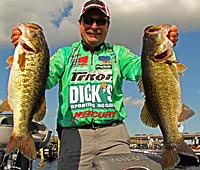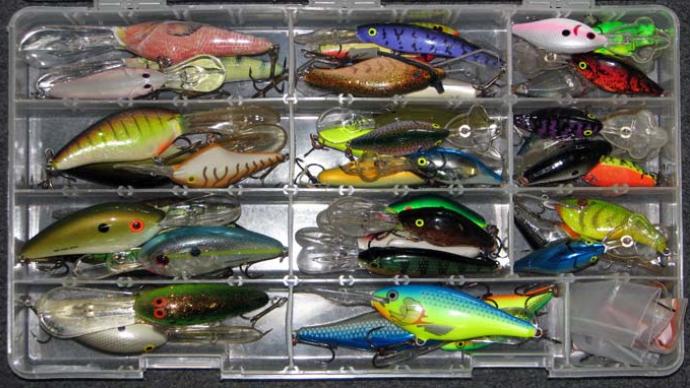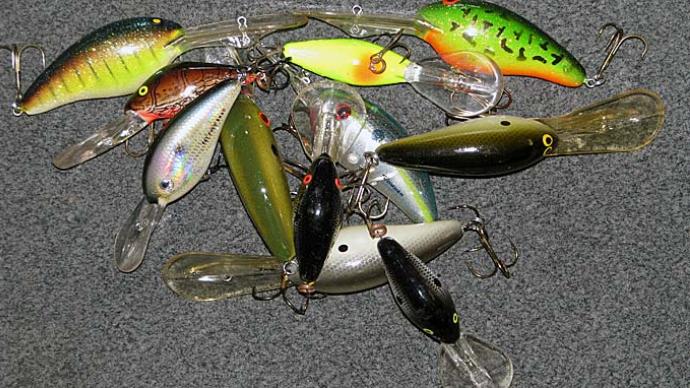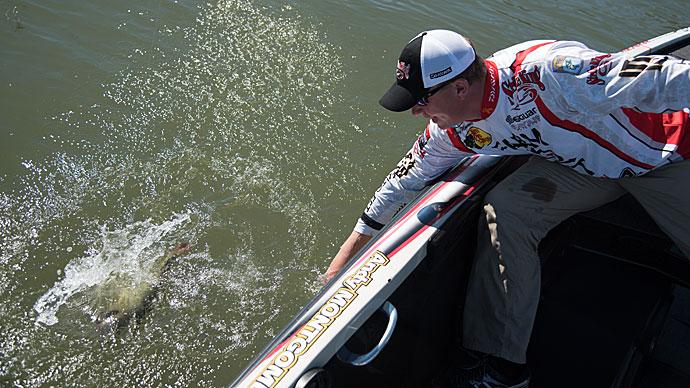
When fishing deeper water for bass, folks often think of using a weighted soft plastic like a worm, lizard, or jig. However, the same significant advantage that a crankbait has in working shallow-water bass applies to deeper-water areas. This, of course, is the ability to cover greater areas of water in a given period. In addition, the speed of covering given types of cover and depths allows you to work through variables and establish a reproducible pattern.
There are some important concepts that a fisherman needs to understand when trying to factor in the type of lure he will use for targeting deeper bass. Not many years ago, the major plugs considered deep divers were oversized versions of the plugs you would use in casting. However, there was a slight problem with the concept. While a larger-sized Hellbender, Bomber Waterdog, or MudBug would reach deeper haunts when trolled, the same didn't apply when casting the plugs. For starters, you couldn't get out the same line on a cast, and secondly, you couldn't get anywhere near the same speed of retrieve with a reel as with trolling. If you tried (and I did), the best reels would die a slow and painful death, not to mention your arms and wrists. I used to throw these plugs and, on occasion, still do. However, it is usually not related to a desire to get the lures deep on the retrieve but rather when I am trying to take advantage of their size for increased visibility, as when fishing selectively for larger fish. In muddy or stained water, the extra size also permits the bass to detect them more easily as prey by enhancing their recognition by sight.
In the last ten years, there have been an ever-increasing number of true deep-diving baits. These have been developed through the application of elongated lips on plastic molded lugs, which in some cases have also been modified by having a slight bend at the end of the lip. This bend enhances the dive of the plug in the water by giving it a steeper dive angle upon retrieval. This concept will work on any plug that dives on the retrieve to a certain degree. You can alter the dive angle by adding weight to the front of the plug. I do this to some floating/diving plugs by placing a screw into the belly of the plug just behind the lip. This must be precisely on the mid-line, or you will change the tracking of the plug on the retrieve. You can also alter a plug in somewhat the same way by adding an oversized treble in the front hook position. By the same logic, the bait will dive at a steeper angle due to its shifted weight. But on the downside, because of the larger hook, it will be less weedless.
If you look at most deep-diving plugs, they have a couple of in common. First, the lip will be proportionally larger in ratio to the body size, and the other feature is that many of these, when viewed from the front or back, will have a narrow body contour from side to side. The lip aids in the dive, but its effect would be useless if the body couldn't cut through the water with less resistance. Another common characteristic of diving plugs is that plugs with wider wobbles on retrieve are less likely to go as deep with the same retrieve speed as a comparable size plug with a tight wobble.
The depth to which a lure is supposed to dive has always been a mythical factor to me. I once had a chance to get the straight scoop on one product from a designer about how his particular plug was rated to dive to a given depth. The curious question was raised because I had marked various actual depths with buoys and tested the dive levels by assessing when I no longer hit bottom on the retrieve. I was off about six feet from the rating noted on the package. The answer had nothing to do with the length of the cast nor the speed of retrieval but simply with the size of the line used in the company test. Their data was OK, but in the real world, you wouldn't cast a 20-foot rated plug on a six-pound test many times due to the stress on the small diameter line. And even fewer if you were in any place where there was underwater structure.
Speaking of structure, many deep divers are amazingly more weedless than you might think. The reason for this is that during the retrieve, the same sharp diving angle will protect the hooks because of the plug's body and lip. If you release pressure upon feeling resistance, the plug will often float back off the hang-up. If that doesn't work, getting on the opposite side of the hang-up and applying pressure will often get many more free. I can tell you the more you fish cranks and learn the feel of fish versus brush, the more often you will avoid hanging up.
You have probably had someone recommend a cranking rod for deeper cranks. Using a glass rod for these baits was fashionable for a while because it has a soft backbone and the flex enabled you to play the fish with less chance of losing them. However, I chose a different approach in using a medium-heavy or heavy graphite rod because I want to place appreciable pressure on the fish when necessary, such as in wooded areas. If you are going to fish deep-diving crankbaits, I would suggest using nothing less than a 6-1/2- foot rod. When using the larger and deepest diving plugs, I go to a 7- or even a 7-1/2-foot rod. These longer rods allow me to make a maximum distance cast (if I choose) and also give me a rod that takes much of the shock from the lure pressure on retrieve (which isn't a wrong concept since the other option is wear and tear on the old body parts).
The gears have been beefed up on most quality reels to get a reasonable life expectancy even if you throw a lot of deep cranks. I prefer to use a higher ratio gear reel to control slack and move the fish when needed.
It is important to keep sharp hooks on deep-diving crankbaits since you will have limited time to detect a strike, and often a fish bites at the end of a long cast. More of a problem is that a fish may not be going in a direction that will take up the slack. So you are trying to get a good hookset and fighting slack simultaneously.
Other variations of cranks that dive suspend when you stop the retrieve. This is an excellent option since most strikes with any bait, including a crankbait, occur when you begin a stop or start action. You should try variations on retrieving from near constant (which works best when bass are in a chasing mood) to variations of start-and-stop (which work most of the time when you need to trigger a strike).
Since all crankbaits have drag resistance to some degree, you might be interested in my rating as to those who give you the most "dive depth" with the least wear on the wrists. The winners are, in my opinion, the Mann's 20+ series and the Excalibur Fat Free Shad series, with the Norman DD 22 just behind.
So you would fish with deep cranks, but you don't like the effort of "driving" a bait to a maximum diving depth. Well, it doesn't have to float to be a deep crankbait. Those with count-down potential are also excellent deep cranks. About 95 percent of fishermen don't work swimming-type baits such as Rat-L-Traps by letting them sink into the deeper water. It is too bad since it's much less work to count down one of these plugs than crank a diver to the same depth. Plugs such as these are only as effective as your knowledge of the depth to which you let it sink. That is, if you want to use them to establish a reproducible pattern. So don't just throw and let it sink. Count it down. While you have less control over the constant depth of a diver-type of crankbait, you can much more easily control the depth on the retrieve of a Trap or Hot Spot.
If you're serious about fishing a deep crankbait, consider the advantages of using a snap for attaching the plug to the line. It gives you the advantage of being able to change plugs quickly without retying each time and giving your bait another pivot point for greater wiggle on the retrieve.
A common concern for folks using a crankbait is that they will hang up. Of course you will hang up, so it is wise to use a sufficiently heavy line to feel comfortable that you will be able to get most of your lures free. As I mentioned, the more you use a crank, the more you will get the feel, and the more often you will "feel" your way through the brush on the retrieve.
Unless you have a friend at the factory, you may have noticed that the lures I have described aren't free. So you may want to invest in buying a lure retriever. These gems won't take long to pay for themselves in reducing lost baits. Most tackle shops have various versions, or you can build one from a saltwater lead and a couple of dog collar drop chains dangling from the lead. These will often foul-hook the plug if the lead doesn't knock the bait loose on the drop. Either way, you are usually back in business.
Deep cranks are just as versatile as more commonly used shallow-water baits. If you have yet to use them as part of your arsenal, obtain at least one rod suited for this type of fishing and set aside a period on each trip to gain confidence in the technique. Be warned, it can grow on you as you realize the potential and versatility.




